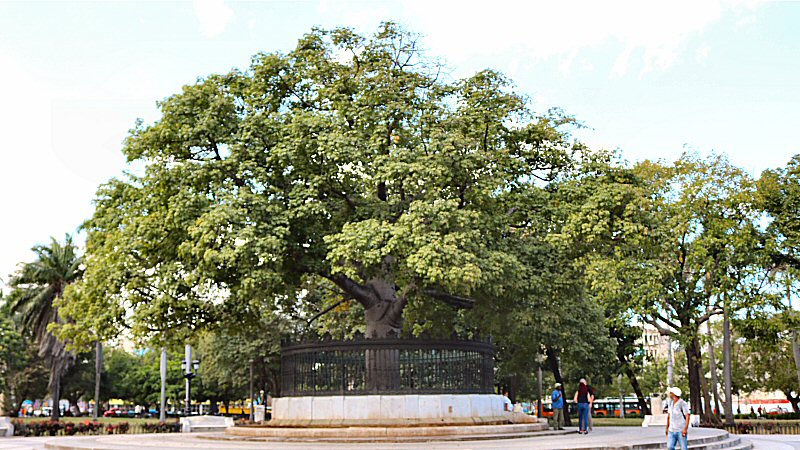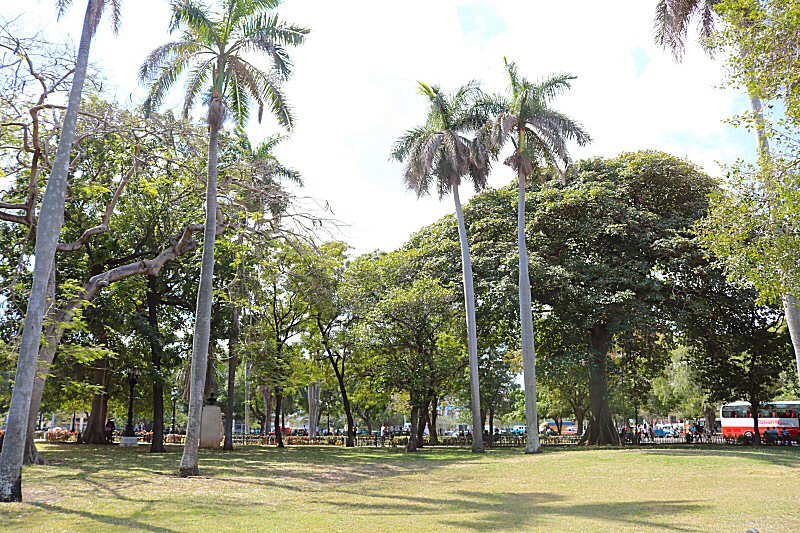Localization
The Parque de la Fraternidad is located south to the
Capitol, bordered by the Paseo de Martí, the Dragones, the
Amistad and the Simón Bolivar streets.
 After the town of Havana was founded,
the former extramural place that the Parque de la
Fraternidad occupies today, stayed as a desolate area for
centuries, because it was a mangrove swamp with abundant
trees, and therefore barely passable. Towards 1790 this area
became an area that the army used for the military
exercises. Even though the military area, called Campo
de Marte, was extended and ameliorated according the project
of the Belgian engineer Augustin Cramer in 1793, it had
still a wild appearance. Bishop Juan José Díaz de
Espada (1756-1832) put the area in order by improving its
layout and installing lighting. Espada was one of the most
important figures of the first half of the 19th century. His
efforts on renovating and modernizing the island is
considered a determining factor at the process of forming a
Cuban culture. During the rule of the Captain General Don
Miguel Tacón (1834-1838) the area was included in the
beautification project of the city. Campo de Marte that
occupied about 27.000 m2, was surrounded by a stone wall
with metal spear that was one meter high to avoid the
passers of the hazards of the military exercises. Majestic
gates were opened at each cardinal point of the wall,
crowned by coat of arms. The names of some important figures
were given to each gate, so that the gate at the north was
called Cortés, at the south, Pizarro, at the east, Tacón and
at the west, Columbus.
After the town of Havana was founded,
the former extramural place that the Parque de la
Fraternidad occupies today, stayed as a desolate area for
centuries, because it was a mangrove swamp with abundant
trees, and therefore barely passable. Towards 1790 this area
became an area that the army used for the military
exercises. Even though the military area, called Campo
de Marte, was extended and ameliorated according the project
of the Belgian engineer Augustin Cramer in 1793, it had
still a wild appearance. Bishop Juan José Díaz de
Espada (1756-1832) put the area in order by improving its
layout and installing lighting. Espada was one of the most
important figures of the first half of the 19th century. His
efforts on renovating and modernizing the island is
considered a determining factor at the process of forming a
Cuban culture. During the rule of the Captain General Don
Miguel Tacón (1834-1838) the area was included in the
beautification project of the city. Campo de Marte that
occupied about 27.000 m2, was surrounded by a stone wall
with metal spear that was one meter high to avoid the
passers of the hazards of the military exercises. Majestic
gates were opened at each cardinal point of the wall,
crowned by coat of arms. The names of some important figures
were given to each gate, so that the gate at the north was
called Cortés, at the south, Pizarro, at the east, Tacón and
at the west, Columbus.
The place is remembered also by a number
of historical events that occurred here. In 1800 the Cuban
actor Francisco Covarrubias, known as the father of the
Cuban theatre, put on his plays in a tent, called El Circo,
that was installed in Campo de Marte. In 1856,
after a few
unsuccessful attempts, the intrepid Portuguese
Matías Pérez
rose to the heights with his hot-air balloon La Villa de
Paris from the Campo de Marte, but he never returned back,
as he disappeared in the ocean. At the present time, when
something vanishes suddenly, you may hear that a Cuban may
say “voló como Matías Pérez (flew away like Matías
Pérez)”. In 1890
the workers in Havana celebrated May 1, the International
Worker’s Day, for the first time in Cuba by parades in this
area, but the following years the celebrations that would be
held in open areas, were prohibited by the Spanish colonial
government. In the second decade of the 19th century, it was
a place where bullrings were organized.
In the second half of the 19th
century, the idea of erecting a monument, dedicated to
Christopher Columbus, in the center of the Campo de Marte
and transferring his ashes from the Cathedral of Havana to
this monument, had many proponents, and many people were
almost certain that this place would carry the name of the
Genoese sailor, but the project was confronted with big
resistance of the bishop, so that it was called off by
itself by passage of time. Even so, the place was known as
Parque Colon for a long time.



 After the town of Havana was founded,
the former extramural place that the Parque de la
Fraternidad occupies today, stayed as a desolate area for
centuries, because it was a mangrove swamp with abundant
trees, and therefore barely passable. Towards 1790 this area
became an area that the army used for the military
exercises. Even though the military area, called Campo
de Marte, was extended and ameliorated according the project
of the Belgian engineer Augustin Cramer in 1793, it had
still a wild appearance. Bishop Juan José Díaz de
Espada (1756-1832) put the area in order by improving its
layout and installing lighting. Espada was one of the most
important figures of the first half of the 19th century. His
efforts on renovating and modernizing the island is
considered a determining factor at the process of forming a
Cuban culture. During the rule of the Captain General Don
Miguel Tacón (1834-1838) the area was included in the
beautification project of the city. Campo de Marte that
occupied about 27.000 m2, was surrounded by a stone wall
with metal spear that was one meter high to avoid the
passers of the hazards of the military exercises. Majestic
gates were opened at each cardinal point of the wall,
crowned by coat of arms. The names of some important figures
were given to each gate, so that the gate at the north was
called Cortés, at the south, Pizarro, at the east, Tacón and
at the west, Columbus.
After the town of Havana was founded,
the former extramural place that the Parque de la
Fraternidad occupies today, stayed as a desolate area for
centuries, because it was a mangrove swamp with abundant
trees, and therefore barely passable. Towards 1790 this area
became an area that the army used for the military
exercises. Even though the military area, called Campo
de Marte, was extended and ameliorated according the project
of the Belgian engineer Augustin Cramer in 1793, it had
still a wild appearance. Bishop Juan José Díaz de
Espada (1756-1832) put the area in order by improving its
layout and installing lighting. Espada was one of the most
important figures of the first half of the 19th century. His
efforts on renovating and modernizing the island is
considered a determining factor at the process of forming a
Cuban culture. During the rule of the Captain General Don
Miguel Tacón (1834-1838) the area was included in the
beautification project of the city. Campo de Marte that
occupied about 27.000 m2, was surrounded by a stone wall
with metal spear that was one meter high to avoid the
passers of the hazards of the military exercises. Majestic
gates were opened at each cardinal point of the wall,
crowned by coat of arms. The names of some important figures
were given to each gate, so that the gate at the north was
called Cortés, at the south, Pizarro, at the east, Tacón and
at the west, Columbus.
